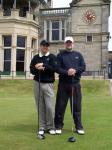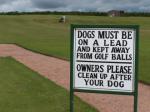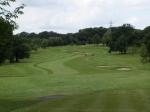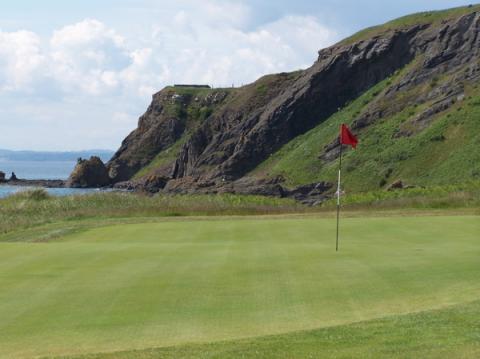
I was captivated by the views from almost everywhere on the Lundin Golf Club links.
After a glorious couple of weeks of golf and visits with family and friends in the United Kingdom, we are back in the U.S. of A. I probably played more golf in the UK than was good for my game; I haven't walked eight courses within 11 days since I was in my early 30s. At a certain age, the law of diminishing returns seems to kick in after a week of virtually daily golf, even though I feel healthier for having walked almost
 between that group and the true links courses we played at Lundin, Elie, Crail and, of course, St. Andrews. The Scottish links are firmer, less sculpted, and more natural looking than their American counterparts. The perfectly shaped sod bunkers we played around and, occasionally, into certainly were not carved by sheep huddling against the harsh winds, but it was easy to imagine that scene hundreds of years ago. Links golf in Scotland is golf darn close to its primordial state.
between that group and the true links courses we played at Lundin, Elie, Crail and, of course, St. Andrews. The Scottish links are firmer, less sculpted, and more natural looking than their American counterparts. The perfectly shaped sod bunkers we played around and, occasionally, into certainly were not carved by sheep huddling against the harsh winds, but it was easy to imagine that scene hundreds of years ago. Links golf in Scotland is golf darn close to its primordial state.

A brooding sky just added to the experience of playing the Old Course for the first time. So too did the old sod bunkers as here at the 12th green.
Some explanatory notes follow our rankings (below). If you are planning a Scottish golf vacation in the area of St. Andrews, I would be happy to share more details about our trip and experiences (just hit the "Contact Us" button above). In the coming days, I'll offer some additional reflections and observations about golf and travel in the Kingdom.
Larry's ranking (Tim's ranking in parentheses):
1. Sunningdale Old Course (1)
2. St. Andrews Old Course (2)
3. Crail Balcomie Links (4)
4. Elie Links (5)
5. Scotscraig Golf Club (3)
6. Lundin Golf Club (6)
7. Hartsbourne Country Club, London (8)
8. St. Andrews New Course (7)
Explanation:
As I wrote yesterday, the Willie Park designed Sunningdale Old Course, updated by Henry Colt in the ‘20s, was a revelation, tough and beautiful and a pleasure no matter what score you produce. The Old Course at St. Andrews was no letdown for us, as it has been for others; its charms are as obvious as some of its pot bunkers are not. I finally played the Old Course at St. Andrews after 60 years; it only took my son Tim 18 years, but isn't that the way it is supposed to be, one generation improving the lot of the next one?
Crail Balcomie was everything a seaside links course should be, challenging on breezy days and a brute when the wind blows. We played it twice, once under each condition, although we did not suffer a drop of rain. I thought Balcomie played four or five strokes harder in the wind. Elie Links was the toughest walk of the eight courses. Its hills seemed a little steeper than at other courses we played; the volcano-induced rock formations at the edges of some holes only heightened (ahem) the drama. Scotscraig was easily the most efficiently designed course we played, on just 106 acres. With only a few blind shots, it was probably the only track where the yardage book was not essential (we referred to it anyway).
breezy days and a brute when the wind blows. We played it twice, once under each condition, although we did not suffer a drop of rain. I thought Balcomie played four or five strokes harder in the wind. Elie Links was the toughest walk of the eight courses. Its hills seemed a little steeper than at other courses we played; the volcano-induced rock formations at the edges of some holes only heightened (ahem) the drama. Scotscraig was easily the most efficiently designed course we played, on just 106 acres. With only a few blind shots, it was probably the only track where the yardage book was not essential (we referred to it anyway).
Lundin's dramatic first hole along the sea, with the seaside town lurking a mile beyond the green, set the tone for the rest of the round there. Though we pushed inland on our walk, the sea was almost always in view, a lovely backdrop for the few holes that played downhill toward the beach. Hartsbourne, just north of London, is more in the style of a U.S. country club, with an active membership and pampered course that was among the best conditioned of the week. Not the high drama of the links courses, but a refreshing change.
inland on our walk, the sea was almost always in view, a lovely backdrop for the few holes that played downhill toward the beach. Hartsbourne, just north of London, is more in the style of a U.S. country club, with an active membership and pampered course that was among the best conditioned of the week. Not the high drama of the links courses, but a refreshing change.
Finally, we might have ranked the New Course at St. Andrews higher had we not played the Old Course (thankfully after we played the New). The best views from the New are of the city of St. Andrews, the same as you get at the Old, but the layout, which seemed fresh to an American who plays links courses rarely, ultimately seemed Old Course lite. The New was a disappointment only in comparison with the Old.

High drama: Cliffs and sea frame the 13th green at Elie Links.
Page 767 of 1030